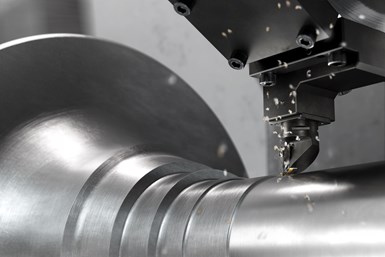Sandvik Coromant Turning Grade Enables High-Feed Roughing
The GC4405 steel turning grade features a new carbide substrate with an optimized microstructure, which reduces plastic deformation in high-feed applications.
Sandvik Coromant’s GC4405 steel turning grade is designed to provide high metal removal rates in stable conditions, particularly in harder steels. The option to machine dry in softer steels also offers opportunities for more sustainable machining.
According to Sandvik Coromant, Grade GC4405 should be applied as a high-feed productivity optimizer with high metal removal rates in stable conditions with demanding plastic deformation properties.
The GC4405 features a new carbide substrate with optimized microstructure, which reduces plastic deformation in high-feed applications, enabling an expansion in the application range toward harder steels and higher productivity compared to the existing grade GC4305.
The new grade GC4405 features the second-generation Inveio technology coating, which is designed to combat crater wear common to P05 applications. What makes the second-generation Inveio different from the earlier generation is the alumina coating, where the crystals are aligned even more vertically toward the top surface to improve wear resistance, offering more consistent quality and performance.
Grade GC4405 is recommended for continuous roughing to semi-finishing in stable conditions and long time in cut. It is suitable for high-feed machining with medium, roughing or wiper geometries in harder steels above 300 HB, or for high-feed and/or high-speed machining in softer steels below 300 HB.
The grade is ideally applied in ISO application area P05 (P01–P10). It is optimized for P2.5 low-alloy hardened steel but also recommended for high-productivity applications in low-alloy P2.1 and unalloyed P1.2 steel.
Related Content
-
Boring Head Enables Sculpture Hardware to Be Machined on a Lathe
When small job shop Ansonia Manufacturing took on a tricky hardware component job for a “live” glass art sculpture, it realized a boring head would be needed to machine the part complete on its live-tool lathe.
-
The Value of Tool Monitoring on Rotary Transfer Machines
By using a tool monitoring system, shops can save costs associated with machine maintenance and downtime for tool changes while increasing cutting performance.
-
Replaceable-Insert Spade Drill Basics, Advantages
Although solid carbide and indexable-insert drills have their place in a machine shop, replaceable-insert spade drills offer specific advantages for various holemaking operations on machining centers and lathes.
.png;maxWidth=970;quality=90)











.png;maxWidth=300;quality=90)




